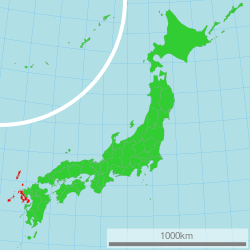Nagasaki Prefecture
|
Nagasaki Prefecture 長崎県 |
|||
|---|---|---|---|
| Prefecture | |||
| Japanese transcription(s) | |||
| • Japanese | 長崎県 | ||
| • Rōmaji | Nagasaki-ken | ||
|
|||
 |
|||
| Country | Japan | ||
| Region | Kyushu | ||
| Island | Kyushu | ||
| Capital | Nagasaki | ||
| Government | |||
| • Governor | Hōdō Nakamura | ||
| Area | |||
| • Total | 4,105.47 km2 (1,585.13 sq mi) | ||
| Area rank | 37th | ||
| Population (2012) | |||
| • Total | 1,407,904 | ||
| • Rank | 26th | ||
| • Density | 351/km2 (910/sq mi) | ||
| ISO 3166 code | JP-42 | ||
| Districts | 4 | ||
| Municipalities | 21 | ||
| Flower | Unzentsutsuji (Rhododendron serpyllifolium) | ||
| Tree | Sawara (Chamaecyparis pisifera) | ||
| Bird | Mandarin duck (Aix galericulata) | ||
| Website | www |
||
Nagasaki Prefecture (長崎県 Nagasaki-ken?) is a prefecture of Japan located on the island of Kyushu. The capital is the city of Nagasaki.
Nagasaki Prefecture was created by merging of the western half of the former province of Hizen with the island provinces of Tsushima and Iki. Facing China and Korea, the region around Hirado was a traditional center for both traders and pirates.
During the 16th century, Catholic missionaries and traders from Portugal arrived and became active in Hirado and Nagasaki, which became a major center for foreign trade. After being given free rein in Oda Nobunaga's period, the missionaries were forced out little by little, until finally, in the Tokugawa era, Christianity was banned under the Sakoku national isolation policy, during which time, Japanese foreign trade was restricted to Chinese and Dutch traders based at Dejima in Nagasaki; however, Kirishitan (Japanese Christian) worship continued underground. These Kakure Kirishitan (hidden Christians) were tried at every step, forced to step on fumi-e ("trample pictures", images of the Virgin Mary and saints) to prove that they were non-Christian. With the banishment of all Catholic missionaries, traders from Catholic countries were also forced out of the country. Along with them, their children, half Japanese and half European, were also forced to leave the country. The majority was sent to Jagatara (Jakarta) and are still remembered by the locals as the people who wrote the poignant letters which were smuggled across the sea to their homeland. Today, Nagasaki has a prominent Chinatown and Catholic churches, and the Churches and Christian Sites in Nagasaki, have been proposed for inscription on the UNESCO World Heritage List.
...
Wikipedia


